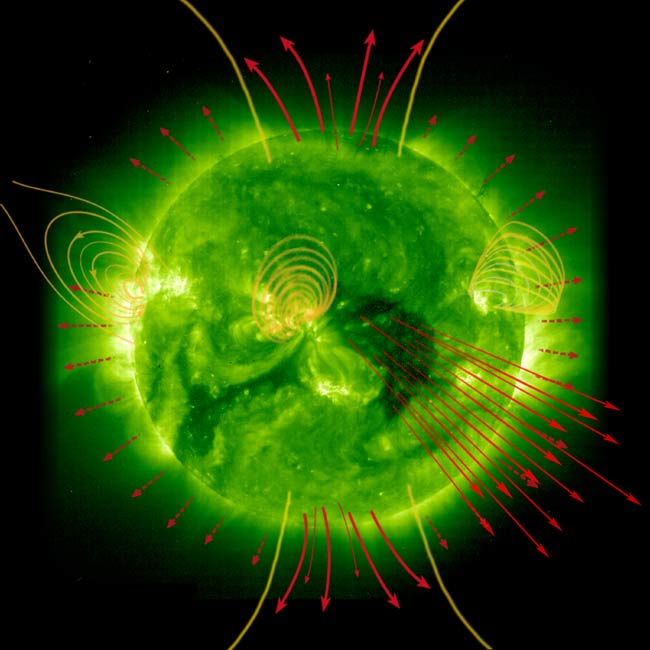Solar Surprise: Electrified Wind Has Deep Origins

Constantly buffeting theEarth and its satellites, the solar wind can gust from 750,000 to 1.5 millionmph. Astronomers would like to predict the dramatic changes in this constantbarrage of charged particles so as to better protect the craft that orbit Earth.
Recent research shows thatthe solar speeds can be accurately measured by observing a relatively deeplayer of the Sun's atmosphere - far beneath where the winds are thought tooriginate.
In what could be a boon tospace weather forecasts, scientists discovered a relation between solar windspeed and fluctuations in the chromosphere - a regiona few thousand miles thick on the outer surface of the Sun.
The findings were asurprise because the solar wind appears to blow out of the lower portions of the hot, wispy corona, which extendsfor millions of miles above the chromosphere.
"It's like discoveringthat the source of the river Nile is another 500 miles inland," said ScottMcIntosh of the Southwest Research Institute.
The solar wind is composedof electrically charged particles that are partly accelerated by magneticfields that permeate the corona.
The magnetic field is called"closed" when it curls back onto the Sun's surface. The solar wind is slower and denser coming outof a closed region.
Get the Space.com Newsletter
Breaking space news, the latest updates on rocket launches, skywatching events and more!
But the fastest windparticles are channeled down "coronal holes" - places where themagnetic field lines point out into space, in a configuration called"open." Coronal holes can beseen as large, dark spots in X-ray images of the corona, which generally emitscopious amounts of X-rays because it is millions of degrees Fahrenheit.
The chromosphereis much cooler than the corona and can only be seen during an eclipse. Theother times it is overwhelmed by the bright photosphere - the layer just belowthe chromosphere, where majority of sunlight comesfrom.
Using NASA's Transition Region and CoronalExplorer (TRACE)spacecraft, McIntosh and his collaborators measured stellar sound waves traveling through the chromosphere and determined that this layer was stretchedthin just below coronal holes.
"This kindof flummoxed us," McIntosh told Space.com. "We thought the chromosphereshouldn't know anything about the coronal hole above it."
To further investigate thiscorrelation, the scientists compared the chromospherestructure to the speed of the corresponding wind as it whisked by the Earth. Itturned out the solar wind velocity could be estimated accurately just bymeasuring the chromosphere below which it originated.
The discovery is expected toimprove space weather forecasts. This is vital to communication satellites,which are vulnerable to space storms. In the future, if humans ventureback to the Moon and on to Mars, broader and better cosmic storm predictionswill be necessary.
The worstradiation events arise out of coronal mass ejections (CMEs)- when the Sun expels billions of tons of solar wind particles in one blast. ACME can accelerate particles as it plows through the solar wind in front ofit. By knowing the speed and density ofsolar wind "fronts" around the Sun, scientists may predict how severe theeventual storm will be.
"Just as knowing moredetails about the atmosphere helps to predict the intensity of a hurricane,knowing the speed of the solar wind helps to determine the intensity of spaceradiation storms from CMEs," said Robert Leamon of NASA's Goddard Space Flight Center.
McIntosh and Leamon are the authors of a paper describing the researchin the May 10 issue of the Astrophysical Journal.
Until now, much of ourinformation about the solar wind and storms has come from relatively nearbyspacecraft like ACE, WIND, and SOHO.
"This spacecraft fleetwas placed along the Earth-Sun line because we need to know about the spaceweather coming our way," said Joe Gurman fromGoddard. "However, compared to the size of our solar system, this is avery narrow range; it's like looking through a soda straw."
But with the correlationbetween the solar wind and the chromosphere,scientists will be able to use the data from TRACE to forecast the weather inhalf of the solar system, they said.
- Live SunCams
- Space Weather: FAQ
- Sun Shows Trace of Solar Moss
- Astronaut Threat Is Blowing In the Solar Wind
- Top 10 Sun Images from SOHO
Join our Space Forums to keep talking space on the latest missions, night sky and more! And if you have a news tip, correction or comment, let us know at: community@space.com.

Michael Schirber is a freelance writer based in Lyons, France who began writing for Space.com and Live Science in 2004 . He's covered a wide range of topics for Space.com and Live Science, from the origin of life to the physics of NASCAR driving. He also authored a long series of articles about environmental technology. Michael earned a Ph.D. in astrophysics from Ohio State University while studying quasars and the ultraviolet background. Over the years, Michael has also written for Science, Physics World, and New Scientist, most recently as a corresponding editor for Physics.









